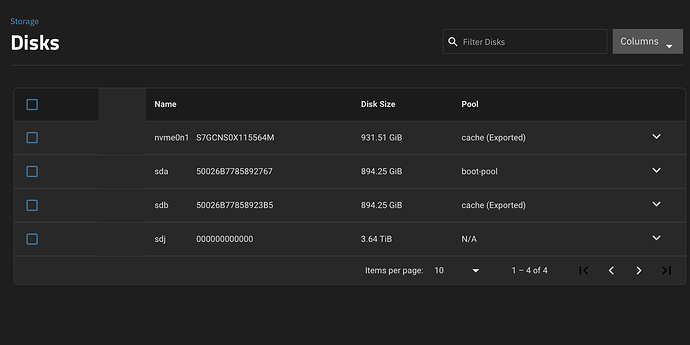I have total of 11 drives connected to the system, but only some of them show up in web UI.
1x nvme, 2x sata SSDs, and an external USB enclosure with 8 drives in.
only the nvme, sata ssds and 1(!) of the usb enclosure drives shows up in the GUI.
admin@truenas[~]$ lsblk
NAME MAJ:MIN RM SIZE RO TYPE MOUNTPOINTS
sda 8:0 0 894.3G 0 disk
├─sda1 8:1 0 1M 0 part
├─sda2 8:2 0 512M 0 part
├─sda3 8:3 0 877.8G 0 part
└─sda4 8:4 0 16G 0 part
└─sda4 253:0 0 16G 0 crypt [SWAP]
sdb 8:16 0 894.3G 0 disk
sdc 8:32 0 3.6T 0 disk
sdd 8:48 0 3.6T 0 disk
sde 8:64 0 3.6T 0 disk
sdf 8:80 0 3.6T 0 disk
sdg 8:96 0 3.6T 0 disk
sdh 8:112 0 3.6T 0 disk
sdi 8:128 0 3.6T 0 disk
sdj 8:144 0 3.6T 0 disk
nvme0n1 259:0 0 931.5G 0 disk
admin@truenas[~]$
I’ve tried booting the system up from a live distro, the drives work fine. I also removed all partiotions from them.
Can I assume this is a software issue if they do show up in lsblk? Or could it be some hardware error as they are not recognized by some reason?
Version:
TrueNAS-SCALE-23.10.2
Possibly due to sharing the same serial number within the enclosure.
Why are you using an 8-bay USB enclosure with TrueNAS, let alone with ZFS?
EDIT: I advise to hide the drives’ serial numbers in your screenshot.
2 Likes
you are right about the serial numbers.
what’s (if any) is your suggested workaround?
admin@truenas[~]$ ls -l /dev/disk/by-id/
total 0
lrwxrwxrwx 1 root root 9 Apr 4 11:09 ata-KINGSTON_SA400S37960G_50026B77858923B5 -> ../../sdb
lrwxrwxrwx 1 root root 9 Apr 4 11:09 ata-KINGSTON_SA400S37960G_50026B7785892767 -> ../../sda
lrwxrwxrwx 1 root root 10 Apr 4 11:09 ata-KINGSTON_SA400S37960G_50026B7785892767-part1 -> ../../sda1
lrwxrwxrwx 1 root root 10 Apr 4 11:09 ata-KINGSTON_SA400S37960G_50026B7785892767-part2 -> ../../sda2
lrwxrwxrwx 1 root root 10 Apr 4 11:09 ata-KINGSTON_SA400S37960G_50026B7785892767-part3 -> ../../sda3
lrwxrwxrwx 1 root root 10 Apr 4 11:09 ata-KINGSTON_SA400S37960G_50026B7785892767-part4 -> ../../sda4
lrwxrwxrwx 1 root root 10 Apr 4 11:09 dm-name-sda4 -> ../../dm-0
lrwxrwxrwx 1 root root 10 Apr 4 11:09 dm-uuid-CRYPT-PLAIN-sda4 -> ../../dm-0
lrwxrwxrwx 1 root root 13 Apr 4 11:09 nvme-Samsung_SSD_990_EVO_1TB_S7GCNS0X115564M -> ../../nvme0n1
lrwxrwxrwx 1 root root 13 Apr 4 11:09 nvme-eui.002538214140e404 -> ../../nvme0n1
lrwxrwxrwx 1 root root 9 Apr 4 11:09 usb-WDC_WD40_EFRX-68WT0N0_000000000000-0:0 -> ../../sdc
lrwxrwxrwx 1 root root 9 Apr 4 11:09 usb-WDC_WD40_EFRX-68WT0N0_000000000000-0:1 -> ../../sdd
lrwxrwxrwx 1 root root 9 Apr 4 11:09 usb-WDC_WD40_EFRX-68WT0N0_000000000000-0:2 -> ../../sde
lrwxrwxrwx 1 root root 9 Apr 4 11:09 usb-WDC_WD40_EFRX-68WT0N0_000000000000-0:3 -> ../../sdg
lrwxrwxrwx 1 root root 9 Apr 4 11:09 usb-WDC_WD40_EFRX-68WT0N0_000000000000-0:4 -> ../../sdf
lrwxrwxrwx 1 root root 9 Apr 4 11:09 usb-WDC_WD40_EFRX-68WT0N0_000000000000-0:5 -> ../../sdh
lrwxrwxrwx 1 root root 9 Apr 4 11:09 usb-WDC_WD40_EFRX-68WT0N0_000000000000-0:6 -> ../../sdi
lrwxrwxrwx 1 root root 9 Apr 4 11:09 usb-WDC_WD40_EFRX-68WT0N0_000000000000-0:7 -> ../../sdj
lrwxrwxrwx 1 root root 9 Apr 4 11:09 wwn-0x50026b77858923b5 -> ../../sdb
lrwxrwxrwx 1 root root 9 Apr 4 11:09 wwn-0x50026b7785892767 -> ../../sda
lrwxrwxrwx 1 root root 10 Apr 4 11:09 wwn-0x50026b7785892767-part1 -> ../../sda1
lrwxrwxrwx 1 root root 10 Apr 4 11:09 wwn-0x50026b7785892767-part2 -> ../../sda2
lrwxrwxrwx 1 root root 10 Apr 4 11:09 wwn-0x50026b7785892767-part3 -> ../../sda3
lrwxrwxrwx 1 root root 10 Apr 4 11:09 wwn-0x50026b7785892767-part4 -> ../../sda4
my plan was to use this as a large but slow volume to archive things.
if this is not a good choice I could add another HBA to the system and use the USB enclosure just as a ‘case’.
You could do this on a non-appliance system, such as a vanilla Linux or FreeBSD system. You would specify a path (such as /dev/disk/by-partuuid) when importing a pool.
However, TrueNAS (an appliance) expects unique serial numbers for each drive, which are sadly obfuscated by many USB enclosures.
EDIT: In case it wasn’t implied: I still wouldn’t entrust my data, backup or otherwise, on a ZFS pool spanned across multiple drives within such a USB enclosure.
If you have the money, you might consider this avenue:
